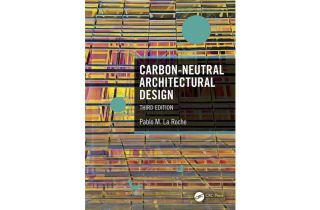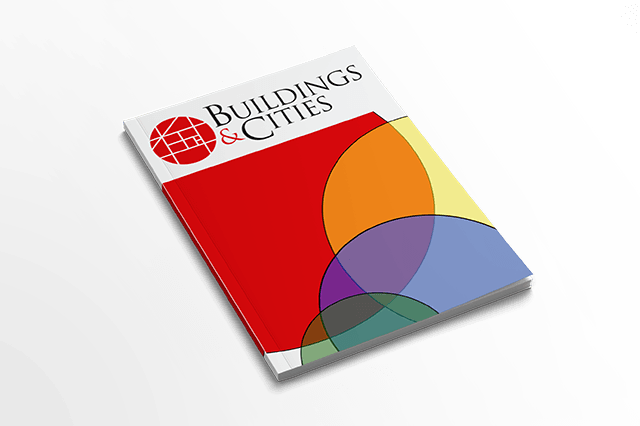
www.buildingsandcities.org/insights/reviews/architectural_epidemiology.html
Architectural Epidemiology: Architecture as a Mechanism for Designing a Healthier, More Sustainable and Resilient World
By Adele Houghton and Carlos Castillo-Salgado. John Hopkins University Press, 2025, ISBN: 9781421450698
Vivian Loftness identified this book as the most unique and critical addition to the body of literature on health in the built environment, invaluable for design professionals and educators, public health leaders, property owners and managers.

Architectural Epidemiology is a transformative book for the building community. From the detailed introduction on environmental epidemiology and the human health impacts of environmental hazards, exposures and human vulnerabilities, to the case studies of design for health at each stage and scale of professional practice, this is an irreplaceable textbook for design.
Written by two deeply accomplished leaders in sustainability, healthy buildings, public health, epidemiology and spatial statistics, this book was a revelation and a gold mine for even a long-term sustainability researcher and practitioner such as myself. The authors leverage their extensive experience in sustainable consulting and health research to analyse the critical intersection of buildings, public health, and climate change. They expand on the work of the most renowned leaders in design for health from organisations including the Green Guide for Health Care (GGHC), the US Centers for Disease Control and Prevention (CDC), the US Green Building Council (USGBC) and the International WELL Building Institute, to enrich the structure and depth of analysis linking human health to the design and operation of the built environment.
The book explores the emerging transdisciplinary field of architecture epidemiology, which focuses on evaluating how the built environment impacts public health. It argues that the current approach to green and healthy buildings is failing to deliver community-scale environmental and health benefits due to a disconnect between the project requirements established for the building itself and the specific context of the project site. Instead, the book advocates for a transition to building communities in a coordinated approach to reduce climate change, improve environmental quality, and encourage residents to adopt an active lifestyle.
The meaning of environmental epidemiology is unveiled with significant depth, championing the value of expertise for architectural practice. Physical, chemical and biological hazards in our environment are introduced across a historic timeline, weighting today’s exposures by physiological, socio-economic and cultural factors. It poses the importance of reducing hazards and exposures at the building, site, neighbourhood, community, regional, national and international scale with a breadth of sustainable design approaches to reduce health risk and improve health outcomes.
Building on this foundation, public health data are introduced to substantiate necessary advancements in evidence-based design for reducing epidemiological exposures and improving health outcomes. The authors expertly introduce an Architectural Epidemiological Toolbox to address a critical set of health challenges: cardiovascular and respiratory disease; obesity, diabetes and hypertension; cancer; and mental health. The Toolbox further addresses design for a critical set of challenges from climate change: extreme heat, flooding, air quality, disasters, and vector borne diseases. The Toolbox identifies the green and sustainable design strategies that can be applied at each scale of design offering evidence on the reduced risks and improved health outcomes.
This Architectural Epidemiological Toolbox is an invaluable asset for designers and public health leaders. Applications of this toolbox at each stage in the building delivery process are illustrated, from programming to schematic design, design development to construction documents, and from construction to occupancy. Prioritised health risks are addressed with evidence-based design and operation strategies and illustrated through case studies from around the world – revealing architectural epidemiology in action. For example, regional design focused on compact mixed-use development with transit and pedestrian infrastructures is linked to: reduced obesity and diabetes; reduced traffic injuries and death; reduced traffic-related air pollution; and improved respiratory health, while enhancing socialisation for mental health. Site planning that avoids flood-prone areas and integrates indigenous landscaping for shade, water management, and walkability can reduce: heat- and flood-related deaths; respiratory disease; as well obesity, diabetes and hypertension. Building design that embraces highly-insulated energy-efficient enclosures can reduce exposure to extreme heat and cold, balanced with operable windows for daylight and natural ventilation to improve sleep, respiratory and mental health. Building-system design for deep energy and water efficiency will also ensure resiliency in the face of power outages and reduce exposures to air pollution and vector-borne diseases. These are only a few of the evidenced-based illustrations that make this book an invaluable reference for the design community.
The business case for evidence-based sustainable and healthy design in the built environment is introduced by exploring real-estate investment models with case studies to prove the viability of embracing evidence-based design. Illustrations of a series of owner-occupied and speculative developments that championed occupant health and productivity in their building projects helps to demonstrate the power of architectural epidemiological design to reduce organisational and individual risk. The case studies span the range of contractual approaches – design-bid-build, design-build, construction manager at risk, integrated project delivery – to quantitatively demonstrate the financial return-on-investment of design for reducing health risks and improving health outcomes.
The book closes with the authors’ vision of a research agenda for architectural epidemiology that could address the gaps in our collective knowledge and enhance our understanding of the role that design, development and facilities operations play in the environmental health of our communities. The agenda emphasises the importance of education, professional practice and research to ensure a future of sustainable design that reduces health risk and improves health outcomes.
Architectural Epidemiology is uniquely positioned at the crossroads of design for sustainability and public health, capturing emerging evidence and statistical analysis that can revolutionise design priorities and justifications for action at the material, building, community and regional scale. The evidence introduced throughout this book is forceful. Moreover, the structural clarity of the authors’ architectural epidemiological construct will support long term additions to evidence-based design solutions that will be catalysing for the future of our built environment.
Latest Peer-Reviewed Journal Content
Designing for pro-environmental behaviour change: the aspiration–reality gap
J Simpson & J Uttley
Lifetimes of demolished buildings in US and European cities
J Berglund-Brown, I Dobie, J Hewitt, C De Wolf & J Ochsendorf
Expanding the framework of urban living labs using grassroots methods
T Ahmed, I Delsante & L Migliavacca
Youth engagement in urban living labs: tools, methods and pedagogies
N Charalambous, C Panayi, C Mady, T Augustinčić & D Berc
Co-creating urban transformation: a stakeholder analysis for Germany’s heat transition
P Heger, C Bieber, M Hendawy & A Shooshtari
Placemaking living lab: creating resilient social and spatial infrastructures
M Dodd, N Madabhushi & R Lees
Church pipe organs: historical tuning records as indoor environmental evidence
B Bingley, A Knight & Y Xing
A framework for 1.5°C-aligned GHG budgets in architecture
G Betti, I Spaar, D Bachmann, A Jerosch-Herold, E Kühner, R Yang, K Avhad & S Sinning
Net zero retrofit of the building stock [editorial]
D Godoy-Shimizu & P Steadman
Co-learning in living labs: nurturing civic agency and resilience
A Belfield
The importance of multi-roles and code-switching in living labs
H Noller & A Tarik
Researchers’ shifting roles in living labs for knowledge co-production
C-C Dobre & G Faldi
Increasing civic resilience in urban living labs: city authorities’ roles
E Alatalo, M Laine & M Kyrönviita
Co-curation as civic practice in community engagement
Z Li, M Sunikka-Blank, R Purohit & F Samuel
Preserving buildings: emission reductions from circular economy strategies in Austria
N Alaux, V Kulmer, J Vogel & A Passer
Urban living labs: relationality between institutions and local circularity
P Palo, M Adelfio, J Lundin & E Brandão
Living labs: epistemic modelling, temporariness and land value
J Clossick, T Khonsari & U Steven
Co-creating interventions to prevent mosquito-borne disease transmission in hospitals
O Sloan Wood, E Lupenza, D M Agnello, J B Knudsen, M Msellem, K L Schiøler & F Saleh
Circularity at the neighbourhood scale: co-creative living lab lessons
J Honsa, A Versele, T Van de Kerckhove & C Piccardo
Positive energy districts and energy communities: how living labs create value
E Malakhatka, O Shafqat, A Sandoff & L Thuvander
Built environment governance and professionalism: the end of laissez-faire (again)
S Foxell
Co-creating justice in housing energy transitions through energy living labs
D Ricci, C Leiwakabessy, S van Wieringen, P de Koning & T Konstantinou
HVAC characterisation of existing Canadian buildings for decarbonisation retrofit identification
J Adebisi & J J McArthur
Simulation and the building performance gap [editorial]
M Donn
Developing criteria for effective building-sector commitments in nationally determined contributions
P Graham, K McFarlane & M Taheri
Join Our Community

The most important part of any journal is our people – readers, authors, reviewers, editorial board members and editors. You are cordially invited to join our community by joining our mailing list. We send out occasional emails about the journal – calls for papers, special issues, events and more.
We will not share your email with third parties. Read more



Latest Commentaries
COP30 Report
Matti Kuittinen (Aalto University) reflects on his experience of attending the 2025 UN Conference of the Parties in Belém, Brazil. The roadmaps and commitments failed to deliver the objectives of the 2025 Paris Agreement. However, 2 countries - Japan and Senegal - announced they are creating roadmaps to decarbonise their buildings. An international group of government ministers put housing on the agenda - specifying the need for reduced carbon and energy use along with affordability, quality and climate resilience.
Building-Related Research: New Context, New Challenges
Raymond J. Cole (University of British Columbia) reflects on the key challenges raised in the 34 commissioned essays for Buildings & Cities 5th anniversary. Not only are key research issues identified, but the consequences of changing contexts for conducting research and tailoring its influence on society are highlighted as key areas of action.